All programs had to apply the CMS demonstration-wide eligibility criteria for participating beneficiaries who were enrolled in Medicare Parts A and B, had Medicare as primary payer, and not enrolled in a Medicare managed care plan. Programs could then develop their own selection criteria. Although all four programs targeted Medicare beneficiaries with a wide range of medical diagnoses and complex conditions, they each targeted different patient populations (See Table 12.1). The HQP program used a formal assessment tool to classify patients into four risk levels. HQP chose not to enroll patients in the lowest of its four risk groups from the inception of demonstration, and it also stopped enrolling moderate-risk patients in 2006 (those in its second-lowest risk group). Two programs, Hospice of the Valley and Mercy, required its enrollees to have at least one hospital admission in the year prior to enrollment. At the start of the demonstration, Washington U identified patients using the proprietary algorithm of a commercial disease management (DM) vendor. After dissolving its partnership with the DM vendor, Washington U targeted beneficiaries with risk of hospitalization over the following year and it relied on referrals from providers to identify potential enrollees.6 Table 12.2 shows the baseline characteristics of the Medicare beneficiaries randomized through December 2006.
Table 12.2 Characteristics of Medicare Beneficiaries*
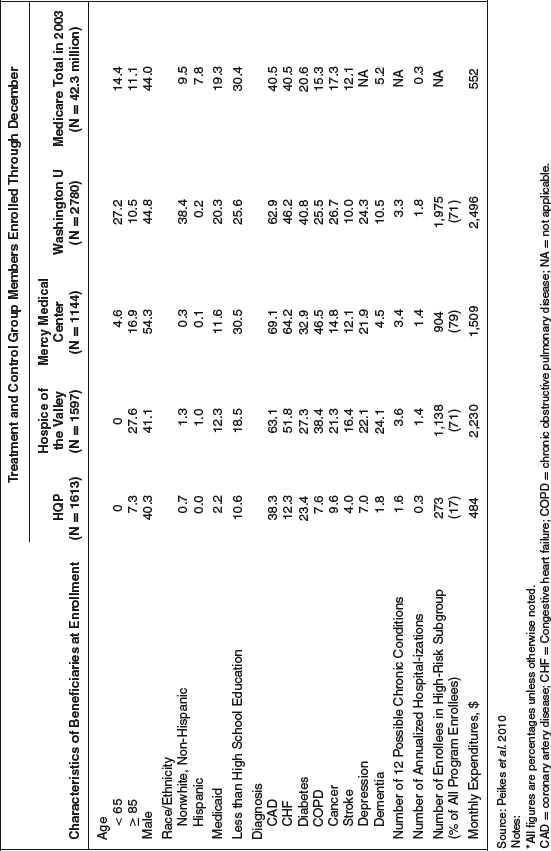
Program structural features
Program structural features include staffing and training (for example, types and number of professionals hired), caseloads, electronic recordkeeping, quality management, and physician relations. These features, in turn, affect the nature, mode, and intensity of care coordinator contacts with patients as well as availability of other clinical and support staff. Table 12.3 illustrates structural features for each program.
Table 12.3 Program Structural Features
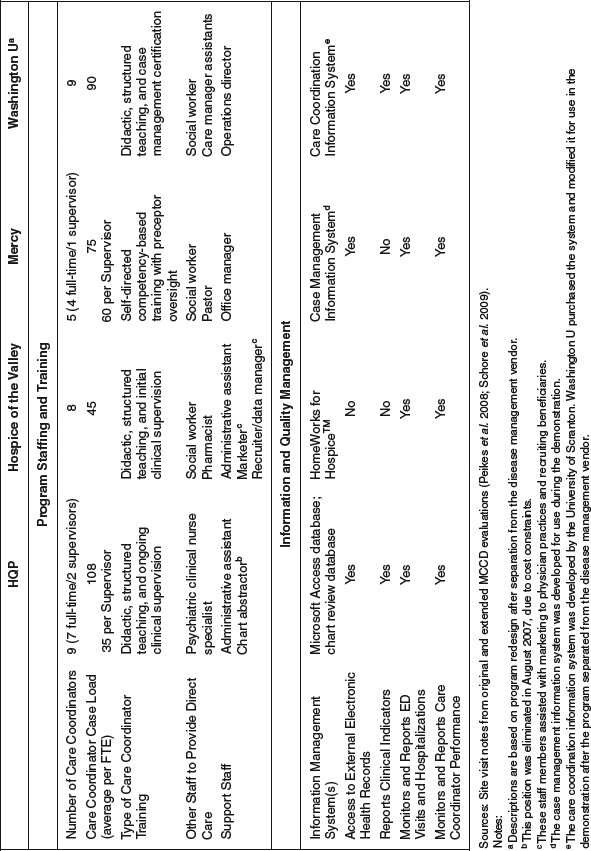
Program staffing and training
All programs required care coordinators to be experienced registered nurses. Washington U also required certification by the Commission for Case Manager Certification. Overall, the programs’ staffing was stable, with very low (or no) turnover among care coordinators over the five years of the demonstration. Mercy, Washington U, and Hospice of the Valley also employed a social worker either full-time or part-time during the demonstration, whereas HQP relied on nurse care coordinators to arrange for social services or to refer patients with complex mental health problems to a psychiatric clinical nurse specialist. Although HQP did not have a dedicated social worker, the project manager was a clinical social worker and served as a resource to care coordinators as needed.
The programs had administrative and/or other clinical staff to support the nurse care coordinators. Mercy had a full-time office manager throughout the demonstration and HQP had either a part-time or full-time administrative assistant throughout the demonstration. HQP also employed a chart abstractor until August 2007, to abstract patients’ clinical measures from physician practice records; it had to eliminate the position due to cost concerns. Washington U had an operations director and augmented its staff with three care assistants who verified program eligibility and assumed clinical responsibility over time as caseloads increased (for example, contacting patients by telephone). Hospice of the Valley also employed an administrative assistant in addition to having a recruiter/data manager and a part-time marketer.
All four programs provided orientation to newly hired care coordinators; however, they each varied in structure, content, and duration. HQP’s care coordinator orientation lasted the longest and included the most in-depth supervision. The three- to six-month orientation used role-playing and shadowing of supervisors; its content included training in behavior change theory and in the provision of group education. Hospice of the Valley’s orientation included one week of formal training covering disease processes, pain management, advance directives, policies and procedures, and community resources, among other topics. It included a field training period of two to six weeks depending on each care coordinator’s educational level and needs. Mercy’s orientation was a four- to six-week, self-guided, competency-based training overseen by another, more experienced care coordinator. Washington U’s orientation included instruction on assessment, care planning, the data management system, and Medicare guidelines and coverage and provided ongoing learning opportunities through team conferences. After separating from the DM vendor, Washington U’s care coordinators also attended continuing education through the local chapter of Case Management Society of America (CMSA).
Caseload size
Staff size, availability of other resources, and most importantly, patient characteristics influenced the size of care coordinator caseloads. HQP care coordinators had larger caseloads than their Hospice of the Valley, Mercy, and Washington U counterparts. Six to seven years into the demonstration, HQP had nine care coordinators: seven with an average of 108 patients, and two supervisors with 35 patients each. However, HQP’s patients were far healthier than those in the other three programs. Hospice of the Valley had eight care coordinators with 45 patients each. Mercy had five care coordinators, four with an average of 75 patients, and one supervisor with 60 patients.7 Washington U had nine care coordinators with up to 90 patients each, although the intention was to maintain a caseload of 70 patients. Based on impacts observed and the cost of employing full-time nurses, it appears that caseloads of 80 to 100 would be necessary to achieve cost neutrality (Brown 2009).
Electronic recordkeeping
Hospice of the Valley used HomeWorks for Hospice case management software that stored assessment, care planning, and monitoring information; however, care coordinators did not have direct access to the system. After its separation from the DM vendor in 2006, Washington U modified a care coordination information system developed by the University of Scranton. The system maintained assessment and preventive screening data, contact dates, reassessment dates, medication lists, hospitalizations and ED visits, and care plans with outcome indicators. The program used these data to monitor program outcomes and care-coordinator performance.
HQP and Mercy developed information management systems to track recruitment, eligibility, enrollment, demographics, emergency contact information, referring physician, and (as required for the evaluation) information on program contacts with patients. Both programs also used paper records to maintain information from the initial and ongoing assessments and to keep detailed notes from contacts. In 2006, HQP began analyzing patient data from its Microsoft Access-based system (which included information abstracted from physician practice records, patient self-reports, and clinical measures – such as blood pressure – that care coordinators obtained directly) using a web-enabled platform, Statit e-QC. This new analytic capability allowed coordinators to generate reports and graphs; a drill-down feature allowed analyses that ranged from program-wide statistics (for example, on the percentage of patients who had flu shots over time), to individual care coordinator caseload statistics, to individual patient data (such as specific patients who had not had flu shots). The reports often compared the outcomes with program- or patient-level goals or national benchmarks. Other reports showed the extent to which needed tests were overdue.
Although none of the programs had a full electronic health records system that linked directly to other providers, HQP, Mercy, and Washington U care coordinators had access to the electronic databases of the hospitals that served the majority (60% to 95%) of their patients.8 These hospital databases included information about hospitalizations, emergency department (ED) encounters, diagnostic testing results, clinic visits with physicians that were part of the hospital system, and medications. The three programs scanned these databases to identify program patients who were hospitalized or had recently visited the ED. Hospice of the Valley had no link to hospital data, thus, there was no consistent access to primary or specialty care physicians’ medical records.
Quality management
Quality management includes ongoing monitoring of the intervention over time to identify opportunities for process improvement and to ensure program effectiveness. This involves systematic data collection and monitoring, evaluating findings, and making changes based on those findings. HQP collected and analyzed data to assess program effectiveness from the beginning of the MCCD, and its capability to perform these functions became more sophisticated over time. Unlike the other programs, HQP care coordinators used reports to track whether their patients as a group were meeting goals and to guide specific behavioral interventions. For example, they used individual patient graphs over time to show patients how they were doing and to link improvements or declines in outcomes (such as weight, blood glucose level, blood pressure) to behavior change or life events. At the program level, managers and care coordinators used reports on program processes and patient outcomes to determine whether the program was meeting its goals concerning patient health and to ensure adherence to standard operating procedures, guidelines, and protocols. The program made decisions to change or add to interventions based on these data and on research suggesting the intervention would be effective for its target population.
After Washington U switched to a different data management system in April 2006 (following its separation from the DM vendor), the program began conducting internal monitoring to assess program effectiveness and care coordinator performance. For example, program directors assessed the timeliness of contacts with patients and providers to ensure adherence to program protocols. They also monitored hospital and ED admissions and other clinical indicators. Findings were shared with individuals’ care coordinators informally; however, if a widespread performance issue was identified, they were all retrained.
Mercy’s quality improvement efforts consisted primarily of the routine assessments of staff competencies conducted for all staff affiliated with Mercy Medical Center, including the Mercy coordinated care program. These assessments focused on two areas of improvement each year. Topics included, for example, increasing rates of influenza vaccination, increasing use of advance directives, and maintaining patient privacy. Mercy also conducted a study in 2006, to determine the effects of reducing in-person contacts on outcomes for established patients and discovered that the reduction resulted in no increase in adverse patient outcomes (for example, hospitalizations). As a result, Mercy care coordinators began to contact patients with whom they had already developed good working relationships more frequently by telephone instead of in person. Although the decision to alter contact mode was based on these data, Mercy’s approach to implementing change more generally tended to be relatively informal and driven by a consensus among care coordinators and other staff that a particular change was needed.
At Hospice of the Valley, quality improvement planning for the coordinated care program was conducted in conjunction with the Hospice of the Valley Quality Improvement Committee. The program monitored the following indicators on a quarterly basis: average number of patient referrals to the program, patient contacts, rates of hospital and ED admissions, and other patient outcomes such as falls. Patient satisfaction was monitored annually. These data were discussed with care coordinators during team meetings, and the group developed a plan if a change was needed, an approach similar to the one used by Mercy.
Programs’ relationships with physicians
Since it can be difficult for a care coordination program external to physicians’ practices to get physicians’ attention, let alone their full participation, all of the programs promoted their care coordinators to physicians as “their eyes and ears” with patients between office visits. To foster care coordinator-physician relationships, HQP, Hospice of the Valley, and Mercy tried to assign patients so that each physician only worked with one care coordinator; however, this did not always happen as geography and the need to balance patient-illness severity level within coordinators’ caseloads usually took precedence. Programs tailored their communications to each physician’s preferences and minimized the amount of paperwork sent.
The two Mercy care coordinators based in the hospital clinics saw physicians more frequently than their HQP, Hospice of the Valley, and Washington U counterparts. Mercy care coordinators in general had strong and collaborative relationships with physicians, due in large part to the care coordinators and many physicians sharing the same employer (Mercy Health Network), and all residing in the same close-knit rural communities. Many had known each other professionally, and sometimes as neighbors, for many years. As a result, physicians and their office staff trusted the care coordinators to triage patient problems. If a care coordinator requested that the physician see a patient immediately, they knew the situation was truly urgent.
Although Washington U care coordinators were not co-located with physicians, they shared an employer with a majority of patients’ physicians. Washington U still had limited contact with physicians even though they shared the same employer. The care coordinators attended physician appointments with some patients and used these opportunities to establish themselves as credible clinicians, and demonstrate their value to physicians. Over time, physicians occasionally contacted care coordinators to see if they were able to attend upcoming appointments and to share patient information. In addition, the Washington U program further strengthened its relations with its patients’ physicians through a physician advisory board that provided input to the programs operating procedures. Members of this board were compensated for their contribution.
Unlike Mercy, the HQP and Hospice of the Valley programs were unable to capitalize on strong pre-existing organizational and physical ties to physician practices. Although some HQP care coordinators had space in physicians’ offices early in the demonstration, these arrangements were terminated as practices grew, eliminating opportunities for informal communication between care coordinators and physicians. HQP also worked with more than 70 different physician practices, which precluded the degree of care coordinator-physician familiarity and communication enjoyed by Mercy. Similarly, although Hospice of the Valley attempted to build care coordinator-physician relationships by having care coordinators attend physician visits and sending patient updates to physicians every six months, they worked with too many physicians’ practices spread over a large geographic region with whom they did not have previous close operational and organizational relationships to establish truly close connections.
Programs’ process features
Programs’ process features are the specific actions performed by the care coordinators, such as assessment, care planning, monitoring, education, and facilitating communication with and among providers. Programs conducted comprehensive assessments, provided self-management education, served as a liaison between providers and patients, and used a comprehensive approach to medication management. HQP and Washington U were distinguished, however, by their use of structured protocols to standardize the management of care transitions across all care coordinators. For example, both programs used protocols that specified when and how to contact hospitalized patients and when to follow up during the post-acute care period. Both HQP and Washington U also received timely notification of hospital admissions for a majority of their patients. Mercy and Hospice of the Valley relied much more on their care coordinators’ discretion to determine the details of their interventions (for example, when a care coordinator contacted a patient after discharge from the hospital).
Assessment
The assessment process provided care coordinators with a picture of the patient’s health, functional status, and resources for self-management, from which the care coordinator identified problems appropriate for the program to address. All four programs’ care coordinators performed initial assessments within two weeks after a patient’s enrollment and also conducted periodic reassessments. HQP, Hospice of the Valley, and Mercy performed the initial assessment in person at the patient’s home and/or physician’s office, whereas Washington U conducted initial assessments by telephone.
The programs’ assessment tools varied widely. Following its pre-random-assignment assessment with the Sutter Health Questionnaire, the tool used to determine level of severity, HQPs highest-risk patients were further divided into those with and without geriatric frailty.9 (High-risk patients with geriatric frailty typically have multiple medical, social, and functional problems that require significant caregiver and social supports.) Those without geriatric frailty then received an in-person disease-specific assessment, and those with geriatric frailty received an in-home geriatric assessment. The in-home assessment covered physical, cognitive, and nutritional status; depression; violence screening; home safety; pain and sleep rating; incontinence; and caregiver ability. As part of the initial assessment for all patients, and periodically thereafter, the care coordinators also conducted physician chart reviews.10 In 2009, HQP began conducting a formal annual reassessment using the Sutter tool.
Table 12.4 Initial Assessment and Problem Identification
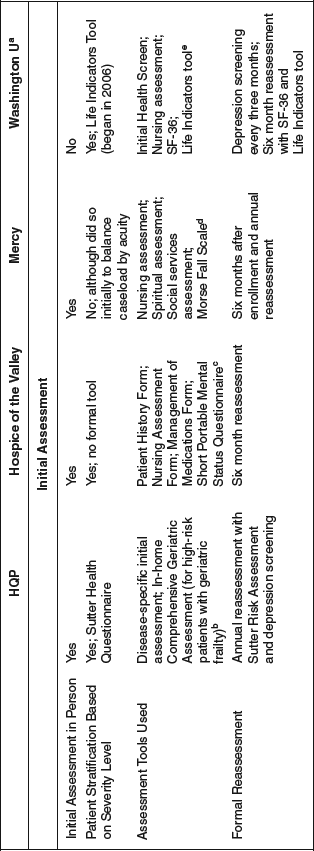
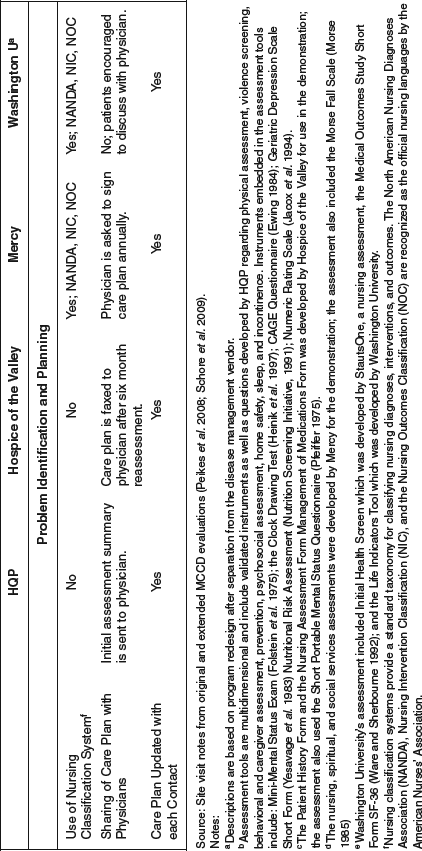
Hospice of the Valley’s initial assessment was always conducted in the patient’s home and included four tools based on the Outcome and Assessment Information Set (OASIS): (1) patient history form, (2) comprehensive care coordinator’s assessment form, (3) management of medications form, and (4) Short Portable Mental Status Questionnaire. In addition, the program used the Missoula-Vitas Quality of Life Index and the MediCaringTM Physician Report. These tools cover medical and surgical history, functional status, nutrition, psychosocial status, availability of social support, caregiver grief, home safety, medications, and a physical and pain management assessment. The initial assessment emphasized end-of-life care and advance directives. For almost all patients, the program also requested medical records information from patients’ physicians and typically received information back on about 85% of these requests. Hospice of the Valley care coordinators performed a formal reassessment using a reassessment tool that includes items from the initial assessment tools. Reassessment occurred every six months or when there was a change in health status or an admission to the hospital or ED.
Mercy’s initial assessment tool was modeled on Mercy Health Network’s home care assessment; it covered medical and surgical history, review of body systems, functional status, nutrition, psychosocial status, availability of social support, home safety, medications, and a social services and spiritual assessment. In 2005, the Morse Fall Scale was added to the initial assessment due to high fall-risk among patients. For the approximately 65% of patients who were part of the Mercy system, care coordinators also drew information for their assessments from the network’s electronic health records system, Cerner PowerChart, which was implemented in 2005. Mercy care coordinators reassessed patients six months after enrollment and annually thereafter using the same initial assessment tools.
At the beginning of the demonstration, Washington U’s initial assessment included the Initial Health Screen (IHS), which was used to identify current conditions, medications, and treatments; recently used health services; activities of daily living; and support needed. This information was used to develop an acuity score that determined the frequency of patient contact with care coordinators. During the next contact, care managers then completed an initial comprehensive nursing assessment and a baseline functional status assessment using the Health Assessment Questionnaire, developed by the DM vendor and modeled after the SF-36. After the program separated from the DM vendor and delivered all services locally, the program developed and used the Life Indicators tool to standardize acuity scoring done by care managers. Washington U also implemented the SF-36, which measured physical functioning, role limitations due to physical health and emotional well-being, pain, general health perceptions, and mental health. Patients were screened for depression routinely every three months and were formally reassessed using the SF-36 and the Life Indicators tool every six months.
Care planning
Care planning is an ongoing and dynamic process for developing measureable goals, prioritizing problems identified during assessments, determining the most appropriate approaches to address them, and deciding when they have been resolved. Care plans focus on illness prevention, health promotion and maintenance, patient education, and required support services. Mercy and Washington U care coordinators developed formal nursing care plans using the North American Nursing Diagnoses Association (NANDA) classification system and used the Nursing Intervention Classification (NIC) and the Nursing Outcomes Classification (NOC) systems, which include a taxonomy of standard nursing interventions and patient/family responses to them. Although Mercy sent the care plan to the patient’s primary physician each year to review, add to (if desired), and sign, Washington U did not. As in Washington U’s program, Hospice of the Valley did not share a written care plan with patients’ physicians, but its care coordinators faxed patients’ six-month reassessments to their physicians, noting any changes in condition and new medications. Washington U care coordinators gave patients a written summary of the care document and encouraged them to discuss it with their providers. Although HQP did not use a formal nursing care plan, it did use assessment summaries; these summaries were shared with the patient’s primary provider. In 2009, HQP developed an electronic problem list to prioritize patients’ needs because staff felt they sometimes lost track of less urgent patient problems over time. All programs updated their care plans during each patient contact.
Monitoring
Monitoring includes assessing patient status and responding quickly to physiological, behavioral, and other changes that could lead to a hospitalization or an ED visit. All program care coordinators monitored their patients through regular contacts. These contacts typically included addressing patients’ ongoing needs, identifying new needs, and following up on progress toward care plan goals. Other specific topics covered were whether the patient had an ED visit or hospitalization since the last contact, and if so, why, as well as how a repeat event could be avoided – and a discussion of physician visits, both planned and unplanned, since the last contact. Medication management was also an important focus during contacts. Care coordinators asked patients at every contact about changes in medications since the last contact, whether medications were having the desired effect, adverse reactions, whether they were being taken as prescribed, and difficulty obtaining or affording medications. If necessary, the programs helped patients apply for financial assistance to purchase medications or discussed less costly generic alternatives with their physicians. During home visits, HQP, Hospice of the Valley, and Mercy care coordinators also reviewed patients’ medication bottles to ensure the patient understood why he or she was taking the medications, if medications were taken as prescribed, and to identify redundant or expired medications and over-the-counter products that could interfere with prescribed medications.
Because patients may only discuss prescriptions they have filled and omit those prescribed but not filled, all of the programs collected information about patients’ medications beyond patients’ self-reports and medication bottles. Thus, the programs abstracted information from physician charts (HQP), required information from patients’ physicians and pharmacists (Hospice of the Valley and Washington U), or pulled data from electronic health records (Mercy). In addition, Hospice of the Valley required that a pharmacist review all medications for potential drug-drug interactions for patients taking 10 or more medications at a time. If any discrepancies were identified between information sources, care coordinators instructed patients to call their physicians or did so on their behalf.
All programs felt that in-person contacts were critical to establishing trusting relationships in which patients were comfortable telling the care coordinators about new problems and concerns. In particular, visiting patients in their homes allowed care coordinators to observe them in their environment and assess its impact on health status (for example, by evaluating neighborhood and home safety). However, in order to manage their caseloads, care coordinators used a combination of in-person and telephone contacts. According to data collected for the original evaluation (Peikes et al. 2008), during the early years of the demonstration, HQP care coordinators averaged 2.2 contacts per month with their patients (0.92 per month for in-person contacts); Hospice of the Valley averaged 2.5 contacts per month (0.93 in person); Mercy averaged 1.4 contacts per month (0.97 in person); and Washington U averaged 1.2 contacts per month (0.06 in person).11
HQP care coordinators’ in-person contacts took place in the patient’s home, during group education in the program’s main office, at the patient’s physician’s office, or in community locations rented by the program (for example, community centers and a wellness center). Hospice, Washington U’s, and Mercy’s in-person visits took place in the patient’s home, at the patient’s physician’s office and hospital. Hospice of the Valley in-person visits took place in the home.
Table 12.5 Ongoing Monitoring
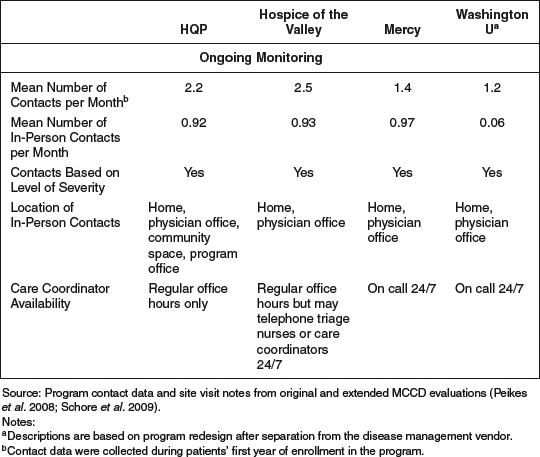
The Hospice of the Valley program did not use guidelines to specify the frequency of visits, rather, the frequency of a patient’s in-person visits depended on how long the patient was enrolled in the program. During the first six months after enrollment, patients were visited as frequently as needed based on the care coordinators’ judgment. If a patient avoided hospitalization or an ED visit during that time and was making progress toward his or her goals, the visit frequency then became monthly, and the care coordinator decided whether these would be in person or by telephone. As mentioned earlier, Washington U used the Life Indicators tool to develop an acuity score which then guided the minimum frequency of contacts. For example, acuity scores range from 1 to 5, with 1 reflecting the highest level of acuity. Patients with acuity scores of 1 or 2 were contacted at least every one to two weeks, whereas patients with acuity scores of 5 were contacted at least every four to six weeks. In contrast to the other three programs that only used care coordinators, Washington U used care manager assistants, who were under the supervision of care coordinators, to contact patients with lower levels of acuity.
Patient education
All care coordinators educated patients on signs and symptoms of disease and problem-solving skills patients needed to confidently manage their chronic conditions. They also taught patients when to call their physicians and coached them on how to communicate more effectively (for example, by reminding patients to prepare lists of questions in advance of physician visits and to always carry current medication lists). They sometimes used role-play to teach patients how to advocate for themselves. Rather than merely conveying factual information, the care coordinators based their education on the transtheoretical behavior change model12 and used the techniques of motivational interviewing.13 However, the programs’ education interventions differed in how consistently they used the transtheoretical behavior change model and how extensively care coordinators were trained in its application. HQP and Washington U care coordinators received formal training in the use of behavior change theory during orientation, whereas Hospice of the Valley provided ongoing guidance on the approach during monthly patient conferences. Unlike the Washington U and Mercy care coordinators, the HQP and Hospice of the Valley care coordinators formally assessed readiness to change during contacts, tailored each educational activity accordingly, and routinely addressed relapse (which, according to the transtheoretical model, is a normal part of the change process). In 2006, HQP also began to use graphs of patients’ clinical data (for example, a graph of weight over time) as educational tools; this allowed patients to make the connection between changes in personal behaviors and changes in outcomes and to see that they had some control over their health.14
HQP care coordinators were the only ones providing group education classes (for patients able and willing to attend).15 The HQP care coordinators were trained to provide cardiovascular education (Heart Healthy workshop); weight loss (LEARN Program) and weight maintenance; physical activity (Active Living Every Day, chair exercise classes, and walking groups); and balance and mobility training (FallProof). HQPs staff added various group education classes after they recognized the need and were able to identify effective programs; the LEARN and Active Living Every Day classes were added in 2004, and FallProof was added in 2005.
Table 12.6 Communication and Coordination with Physicians

Facilitating communication and coordination
One of the challenges facing people with chronic illness is that the communication between their many providers is often poor. Making sure that all providers have key information at the right time and that patients understand the self-care that their providers have prescribed for them is likely to be especially important for high-risk patients who see more physicians, require more diagnostic testing, and take more medications. Patients and their caregivers can take on some of the responsibility of improving communication and coordination, and self-management education in all of the programs included teaching patients (or their caregivers) to coordinate their care across providers, to the extent that they were able to do so. For example, care coordinators emphasized the importance of keeping all providers apprised of any new medications prescribed. Care coordinators also took on the communication facilitator role; that is, they served as a link between patients, physicians, and other providers when problems were identified. The programs differed, however, in that Mercy care coordinators took on the role as part of their routine, day-to-day practice, whereas HQP, Washington U, and Hospice of the Valley care coordinators only did so around specific events or practice issues, such as hospital admissions or urgent patient problems (for example, serious symptoms or significantly out-of-range laboratory values). This role typically included making sure patients got preventive care and diagnostic tests recommended by evidence-based guidelines for their conditions, managing medications (previously described), and helping with care setting transitions (discussed further on). Moreover, Mercy’s two care coordinators who were based in the Mercy Health Network’s internal medicine and family practice clinics had particularly strong opportunities for enhancing communication and coordination. Their frequent informal contact enabled them to routinely share patient information (for example, the results of patients’ visits with specialists since care coordinators attended the visits and diagnostic information from the Cerner system) with their patients’ primary care physicians.
Managing care transitions
Over 20% of chronically ill Medicare patients are readmitted to the hospital shortly after discharge (Jencks et al. 2003); these readmissions are often the result of well-documented failures in communication with patients and coordination among providers that typically occur when patients’ transition from hospital to home (Bodenheimer & Berry-Millett 2009; Coleman et al. 2005a; 2005b; 2006; Flacker et al. 2007; Naylor 2003; Naylor et al., 2004). Patients often leave the hospital with several new medications, some of which are redundant with existing regimens or even contraindicated. Patients’ acute illnesses are improved but still not completely stable, and they frequently go home with an incomplete understanding of what signs and symptoms to look for as warnings of deterioration in their condition, and what to do if problems arise. Once home, they do not fully understand medication and other discharge instructions and may feel too ill to make needed follow-up doctors’ appointments or do not keep them because they do not fully understand their importance. Unfortunately, patients’ primary physicians are frequently unaware that their patients have been hospitalized because they were admitted by a specialist or through the ED (this was, in fact, the repeated experience in the four programs).
In order to intervene in and improve their patients’ care transitions, the care coordination programs had to learn of patients’ hospitalizations in a timely way. As described above, the HQP, Mercy, and Washington U care coordinators had access to the electronic health records of the hospitals that serve most of their patients and thus could scan daily inpatient rosters to see if any of them had been admitted. The Hospice of the Valley care coordinators did not have such access, however, and relied on patients or patients’ families to notify them of any hospitalizations.
Table 12.7 Care Transition Management
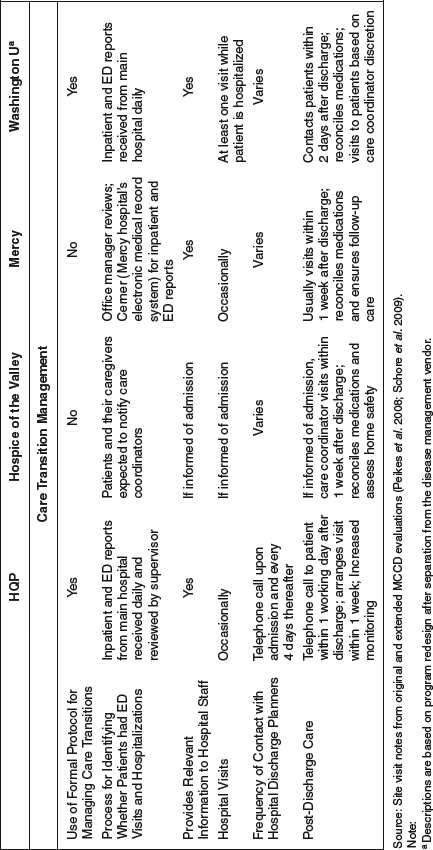
The HQP and Washington U care coordinators followed a structured protocol for hospitalized patients to ensure consistent completion of necessary interventions. In HQPs protocol, care coordinators were required to contact the hospital case manager upon admission and every four days thereafter. They also contacted the patient within one working day after discharge from the hospital and arranged to visit the patient at home within one week. Washington U’s care coordinators were required to contact the patient by phone within 24 to 48 hours after discharge from the hospital and used their discretion to determine the timing of an in-person home visit. In both programs, the focus of these post-discharge contacts, whether in-person or telephone, was to reconcile medications, review signs and symptoms of the precipitating illness, identify strategies to avoid a repeat event, and ensure that patients understand discharge instructions and had scheduled follow-up appointments with their physicians. In contrast, although the Mercy care coordinators communicated with hospital care managers and sometimes visited hospitalized patients, they did not follow an explicit protocol in doing so, relying instead on their experience and judgment. The Mercy program encouraged its care coordinators to make an in-home visit within one week after discharge, with the same goals as the HQP and Washington U’s post-discharge contacts.
The Hospice of the Valley program did not always know about patients’ hospitalizations. However, program management estimated that they knew about hospitalizations for 40% of patients and further determined that care coordinators conducted in-home visits for 80% of these cases within seven days of hospital discharge. Features of Hospice of the Valley’s post-discharge interventions were similar to the other three programs and included identification of the causes of hospitalization, assessing home safety, and reconciling medications.
Improving access to support and counseling services
As noted earlier, the Washington U, Hospice of the Valley, and Mercy programs employed social workers (though Mercy’s was only dedicated part-time to the program, and the social worker employed by Washington U’s program had a dual function as a care coordinator but was available to assist all patients). HQP care coordinators referred patients who needed support services to local Area Agencies on Aging and consulted with a clinical nurse specialist for patients with complex psychiatric problems including personality disorders and cognitive deficits. In addition, HQPs project manager had a background in clinical social work and was available to provide social work input on specific cases as needed. Mercy also had a chaplain affiliated with Mercy Medical Center who counseled program patients if care coordinators determined that they would benefit from pastoral care. None of the programs used a formal procedure to assess the effectiveness of support services to which they have referred patients; rather, they asked patients about their satisfaction with the services during routine contacts.
Summary of promising practices
Although the four programs that reduced hospitalizations among high-risk beneficiaries differed in how they implemented their interventions, six features were consistently present in the programs and could be considered promising practices for adoption by others who seek to deliver effective care coordination. In addition to these practices, other well-intentioned features were used by either all or most of the programs in the original demonstration including: (1) implementation of mutual goals and action plans monitored frequently through patient/family contacts with adjustments made as needed; and (2) use of evidence-based guidelines and protocols for chronic illnesses and geriatric problems. Although these features did not necessarily distinguish programs with impacts from those without, evidence suggests that they are important for delivering individualized care to patients with complex chronic conditions.
The following section first discusses the extent to which the literature supports or refutes targeting high-risk populations, because that is the subgroup that demonstrated favorable outcomes. Then, the section describes the literature related to the six features consistently present in the four programs. In addition to targeting the right population, the promising practices featured:
1. in-person contact with patients approximately monthly (three of four programs also perform the initial patient assessment in-person rather than by telephone16);
2. behavioral change theory and motivational interviewing to guide patient education, coaching and support effective self care;
3. collaborative and interdisciplinary approach to medication management;
4. facilitator of communication with health and community providers when problems arose;
5. comprehensive approach to managing care transitions (three of the four programs also received timely notification of hospital admissions); and
6. opportunities for face-to-face contact with patients’ physicians through, for example, care coordinators attending office visits, co-location with physicians, or regular contact during hospital rounds.17
Stay updated, free articles. Join our Telegram channel

Full access? Get Clinical Tree


